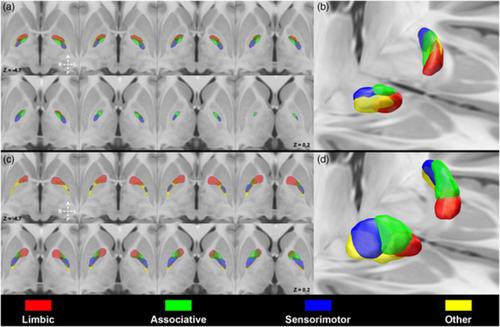当前位置:
X-MOL 学术
›
Hum. Brain Mapp.
›
论文详情
Our official English website, www.x-mol.net, welcomes your
feedback! (Note: you will need to create a separate account there.)
Spatially coherent and topographically organized pathways of the human globus pallidus.
Human Brain Mapping ( IF 3.5 ) Pub Date : 2020-08-05 , DOI: 10.1002/hbm.25147 Salvatore Bertino 1 , Gianpaolo Antonio Basile 1 , Alessia Bramanti 2 , Giuseppe Pio Anastasi 1 , Angelo Quartarone 1 , Demetrio Milardi 1, 2 , Alberto Cacciola 1
Human Brain Mapping ( IF 3.5 ) Pub Date : 2020-08-05 , DOI: 10.1002/hbm.25147 Salvatore Bertino 1 , Gianpaolo Antonio Basile 1 , Alessia Bramanti 2 , Giuseppe Pio Anastasi 1 , Angelo Quartarone 1 , Demetrio Milardi 1, 2 , Alberto Cacciola 1
Affiliation

|
Internal and external segments of globus pallidus (GP) exert different functions in basal ganglia circuitry, despite their main connectional systems share the same topographical organization, delineating limbic, associative, and sensorimotor territories. The identification of internal GP sensorimotor territory has therapeutic implications in functional neurosurgery settings. This study is aimed at assessing the spatial coherence of striatopallidal, subthalamopallidal, and pallidothalamic pathways by using tractography‐derived connectivity‐based parcellation (CBP) on high quality diffusion MRI data of 100 unrelated healthy subjects from the Human Connectome Project. A two‐stage hypothesis‐driven CBP approach has been carried out on the internal and external GP. Dice coefficient between functionally homologous pairs of pallidal maps has been computed. In addition, reproducibility of parcellation according to different pathways of interest has been investigated, as well as spatial relations between connectivity maps and existing optimal stimulation points for dystonic patients. The spatial organization of connectivity clusters revealed anterior limbic, intermediate associative and posterior sensorimotor maps within both internal and external GP. Dice coefficients showed high degree of coherence between functionally similar maps derived from the different bundles of interest. Sensorimotor maps derived from the subthalamopallidal pathway resulted to be the nearest to known optimal pallidal stimulation sites for dystonic patients. Our findings suggest that functionally homologous afferent and efferent connections may share similar spatial territory within the GP and that subcortical pallidal connectional systems may have distinct implications in the treatment of movement disorders.
中文翻译:

人类苍白球的空间连贯和地形组织路径。
苍白球 (GP) 的内部和外部部分在基底神经节回路中发挥不同的功能,尽管它们的主要连接系统共享相同的地形组织,划定边缘、联想和感觉运动区域。内部 GP 感觉运动区域的识别在功能性神经外科设置中具有治疗意义。本研究旨在通过对来自人类连接组计划的 100 名不相关健康受试者的高质量扩散 MRI 数据使用牵引成像衍生的基于连接的分割 (CBP) 来评估纹状体、丘脑下丘脑和苍白球通路的空间一致性。已在内部和外部 GP 上实施了两阶段假设驱动的 CBP 方法。已计算功能同源的苍白球映射对之间的骰子系数。此外,已经研究了根据不同感兴趣途径的分割的可重复性,以及连接图与肌张力障碍患者现有最佳刺激点之间的空间关系。连接簇的空间组织揭示了内部和外部 GP 内的前边缘、中间关联和后感觉运动图。骰子系数显示从不同的感兴趣的束派生的功能相似的地图之间的高度一致性。源自下丘脑苍白球通路的感觉运动图是最接近已知的肌张力障碍患者最佳苍白球刺激位点。
更新日期:2020-10-14
中文翻译:

人类苍白球的空间连贯和地形组织路径。
苍白球 (GP) 的内部和外部部分在基底神经节回路中发挥不同的功能,尽管它们的主要连接系统共享相同的地形组织,划定边缘、联想和感觉运动区域。内部 GP 感觉运动区域的识别在功能性神经外科设置中具有治疗意义。本研究旨在通过对来自人类连接组计划的 100 名不相关健康受试者的高质量扩散 MRI 数据使用牵引成像衍生的基于连接的分割 (CBP) 来评估纹状体、丘脑下丘脑和苍白球通路的空间一致性。已在内部和外部 GP 上实施了两阶段假设驱动的 CBP 方法。已计算功能同源的苍白球映射对之间的骰子系数。此外,已经研究了根据不同感兴趣途径的分割的可重复性,以及连接图与肌张力障碍患者现有最佳刺激点之间的空间关系。连接簇的空间组织揭示了内部和外部 GP 内的前边缘、中间关联和后感觉运动图。骰子系数显示从不同的感兴趣的束派生的功能相似的地图之间的高度一致性。源自下丘脑苍白球通路的感觉运动图是最接近已知的肌张力障碍患者最佳苍白球刺激位点。











































 京公网安备 11010802027423号
京公网安备 11010802027423号